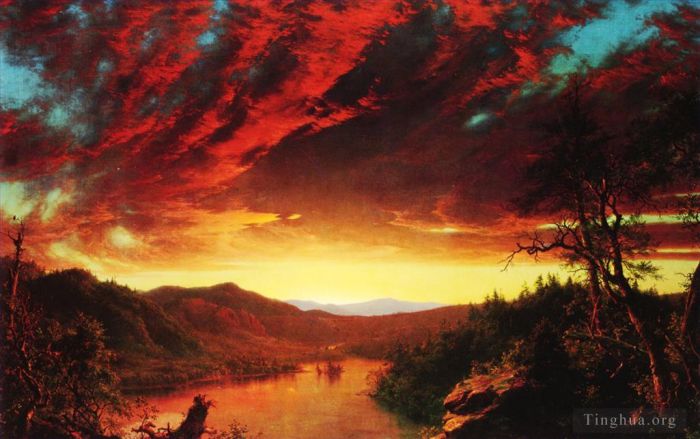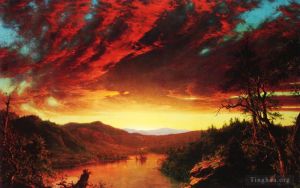Twilight in the Wilderness
Frederic Edwin Church
- Price: Price on Request
- Art Type: Oil Painting
- Size:
- English Comments: 0
- International Comments: 0
- Creating Date:
- Introduction and Works of Frederic Edwin Church >>
Keywords:
Twilight, Wilderness
Work Overview
- Twilight in the Wilderness
Frederic Edwin Church
Date: 1860
Style: Luminism
Genre: cloudscape
Oil on canvas
101.6 x 162.6 cm
The Cleveland Museum of Art
Frederic Edwin Church was one of our country’s consummate artistic talents, and his masterpiece, Twilight in the Wilderness (1860), ranks among the Cleveland Museum of Art’s most admired paintings. This fall, beginning Saturday, October 4, we will showcase the majestic work in a special focus exhibition, Maine Sublime: Frederic Church’s Twilight in the Wilderness, displaying it alongside nearly two dozen the artist painted the canvas in his New York studio, partly basing it on sketches he produced during travels near Mount Katahdin in Maine. Two sketches from Olana that closely relate to Twilight in the Wilderness are highlighted in the exhibition.
Although Church often extolled the breathtaking beauty and sublimity of America’s pristine wilderness in drawn and painted sketches from the artist’s own private collection at Olana, his historic home, studio, and landscaped property on the Hudson River. Several are on public view for the first time.
Rendered with a scientific realism that reflects Church’s abiding interest in natural history, Twilight in the Wilderness is a spectacular view of a blazing sunset over a distant purple mountain. Cloaked amid quickening nightfall, its foreground features a dark crimson lake flanked by masses of dramatically twisted and attenuated trees. Even if the exact scene it depicts is open to debate—in fact, some historians surmise it may be a composite view of multiple locations—it is known that his work, our painting appears to have additional overtones, particularly because twilight is a transitional time so visibly evolving toward an end. Created on the eve of the Civil War, when its outbreak appeared inevitable, the painting’s subject can be perceived as symbolically evoking the coming conflagration; indeed, one scholar has memorably described the painting as a “natural apocalypse.” Other interpretations include the possibility that Twilight in the Wilderness references the increasingly threatened state of our country’s unspoiled natural environment, already an issue during the artist’s day.
- Copyright Statement:
All the reproduction of any forms about this work unauthorized by Singing Palette including images, texts and so on will be deemed to be violating the Copyright Laws.
To cite this webpage, please link back here.
- >> English Comments
- >> Chinese Comments
- >> French Comments
- >> German Comments
- >>Report
- Tropical Landscape
- Icebergs and Wreck in Sunset
- Scene on the Magdalena
- New England Landscape2
- Home by the Lake
- Autumn
- Storm in the Mountains
- Mount Ktaadn
- Cross in the Wilderness
- Twilight in the Wilderness
- The Andes of Ecuador2
- To the Memory of Cole
- Mountains of Ecuador aka A Tropical Morning
- Morning Looking East over the Husdon Valley from Catskill Mountains
- Mount Ktaadn aka Mount Katahdin
- La Magdalena aka Scene on the Magdalena
- Tequendama Falls near Bogota New Granada
- The Evening Star
- View near Stockbridge Mass
- The Iceberg
- Figures in an Ecuadorian Landscape
- The Old Boat aka The Abandoned Skiff
- Jerusalem from the Mount of Olives
- Heart Of The Andes
- View from Olana in the Snow
- Niagara Falls from the American Side
- Cotopaxi
- Landscape with Waterfall
- Grand Manan Island
- Fog off Mount Desert
- The Arabian Desert
- View of Mount Katahdin
- The Wreck
- Hooker and Company Journeying through the Wilderness from Plymouth to Hart
- Niagara Falls
- View in Pittsford Vt
- Above the Clouds at Sunrise
- Aurora Borealis
- Lake Scene in Mount Desert
- The Magdalena River Equador
- Salzburg Castle
- The Andes of Ecuador
- Camp Fire in the Maine Wilderness
- Twilight Mount Desert Island Maine
- South American Landscape
- Landscape in the Adirondacks
- The Icebergs
- North Lake
- The Parthenon
- Autumn on the Hudson
- View of Newport Mountain Mount Desert
- El Khasne Petra
- Autumn Shower
- The Ruins at Sunion Greece
- Landscape in Greece
- Sunrise in Syria
- Autumn in North America
- A Country Home
- Tamaca Palms
- The Natural Bridge Virginia
- Twilight among the Mountains
- Moses Viewing the Promised Land
- Scene among the Andes
- Tamaca Palms2
- Beacon off Mount Desert Island
- On Otter Creek
- Rough Surf Mount Desert Island
- Sunset
- Ira Mountain Vermont
- Coast Scene
- Scene on the Catskill Creek New York
- July Sunset Berkshire County Massachusetts
- New England Landscape with Ruined Chimney
- TwilightShort arbitertwixt day and night
- The Agean Sea
- Figures in a New England Landscape
- Rainy Season in the Tropics
- New England Landscape aka Evening after a Storm
- Winter Scene Olana
- West Rock New Haven
- New England Landscape
- The Cordilleras Sunrise









 Singing Palette
Singing Palette